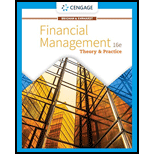
Financial Management: Theory & Practice
16th Edition
ISBN: 9781337909730
Author: Brigham
Publisher: Cengage
expand_more
expand_more
format_list_bulleted
Question
Chapter 22, Problem 7MC
Summary Introduction
Case summary: Company HH is a regional hardware chain which is considering acquiring LL. The boss of the company asked to place a value on target. There are 20 million shares @$12 per share with LL. Bet is 1.25 for LL’s stock with risk free rate 5.5% and market risk premium is 4%. 20% of capital structure of LL is financed with debt with 8% interest rate. Federal plus state tax rate is 25% and will remain same even after acquisition. The management of the company HH is asking various questions about mergers and also asking to perform merger analysis based on the given details of Company LL.
To determine: The amount of Company H should offer shares to LL and the amount per share.
Expert Solution & Answer
Want to see the full answer?
Check out a sample textbook solution
Students have asked these similar questions
What is the difference between a contra asset account and a liability?i need help.
What is the significance of a company’s price-to-earnings (P/E) ratio? i need answer.
What is the significance of a company’s price-to-earnings (P/E) ratio?
Chapter 22 Solutions
Financial Management: Theory & Practice
Ch. 22 - Prob. 1QCh. 22 - Prob. 2QCh. 22 - Prob. 3QCh. 22 - Prob. 4QCh. 22 - Prob. 5QCh. 22 - Prob. 1PCh. 22 - Prob. 2PCh. 22 - Prob. 3PCh. 22 - Hasting Corporation is interested in acquiring...Ch. 22 - Prob. 5P
Ch. 22 - Prob. 6PCh. 22 - Prob. 7SPCh. 22 - Prob. 1MCCh. 22 - Hager’s Home Repair Company, a regional hardware...Ch. 22 - Hager’s Home Repair Company, a regional hardware...Ch. 22 - Hager’s Home Repair Company, a regional hardware...Ch. 22 - Prob. 5MCCh. 22 - Prob. 6MCCh. 22 - Prob. 7MCCh. 22 - Prob. 8MCCh. 22 - Prob. 9MCCh. 22 - Prob. 10MCCh. 22 - Prob. 11MCCh. 22 - Prob. 12MC
Knowledge Booster
Learn more about
Need a deep-dive on the concept behind this application? Look no further. Learn more about this topic, finance and related others by exploring similar questions and additional content below.Similar questions
arrow_back_ios
SEE MORE QUESTIONS
arrow_forward_ios
Recommended textbooks for you

 Intermediate Financial Management (MindTap Course...FinanceISBN:9781337395083Author:Eugene F. Brigham, Phillip R. DavesPublisher:Cengage Learning
Intermediate Financial Management (MindTap Course...FinanceISBN:9781337395083Author:Eugene F. Brigham, Phillip R. DavesPublisher:Cengage Learning Intermediate Accounting: Reporting And AnalysisAccountingISBN:9781337788281Author:James M. Wahlen, Jefferson P. Jones, Donald PagachPublisher:Cengage Learning
Intermediate Accounting: Reporting And AnalysisAccountingISBN:9781337788281Author:James M. Wahlen, Jefferson P. Jones, Donald PagachPublisher:Cengage Learning



Intermediate Financial Management (MindTap Course...
Finance
ISBN:9781337395083
Author:Eugene F. Brigham, Phillip R. Daves
Publisher:Cengage Learning

Intermediate Accounting: Reporting And Analysis
Accounting
ISBN:9781337788281
Author:James M. Wahlen, Jefferson P. Jones, Donald Pagach
Publisher:Cengage Learning
Financial leverage explained; Author: The Finance story teller;https://www.youtube.com/watch?v=GESzfA9odgE;License: Standard YouTube License, CC-BY